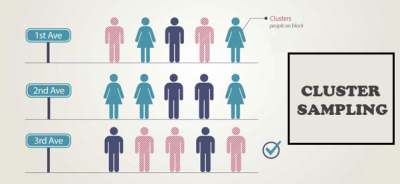Cluster sampling | Definition | Advantages & Disadvantages
Table of Contents
What is a Cluster Sampling?
Definition: Cluster sampling studies a cluster of the relevant population. It is a design in which the unit of sampling consists of multiple cases e.g. a family, a class room, a school or even a city or a school system. Cluster sampling is also known as area sampling. Some authors consider it synonymous with multistage sampling. In the multistage sampling, the cases to be studied are picked up randomly at different stages.
For example, in studying the problems of middle class working people in a state, the first stage will be to pick up a few districts in the state. The next stage will be to pick up a few rural and urban areas randomly for the study. In the third stage, a few families belonging to middle class will be picked up. The last stage will be that of selecting working couples out of these families.
Thus, the stages will be:
 (Image: Cluster Sampling method)
(Image: Cluster Sampling method)
(State –> Districts –> Middle-class families –> Working couple in these families)
Area sampling or Cluster sampling method is employed where the population is concentrated over a wide area and it is not possible to study the whole population at one stage.
Every sampling methods has its own merits and demerits. The following are some of the advantages and disadvantages of Cluster sampling.
Merits of Cluster sampling
Cluster sampling offers the following advantages:
- Cluster sampling is less expensive and more quick. It is more economical to observe clusters of units in a population than randomly selected units scattered over throughout the state.
- Cluster Sample permits each accumulation of large samples.
- The loss of precision per individual case is more than compensated for by the possibility of studying larger samples for the same cost.
- Cluster sample may combine the advantages of both random sampling as well as stratified sampling.
- Cluster sampling procedure enables to obtain information from one or more areas.
Demerits of cluster sampling
The following are the disadvantages of Cluster sampling:
- In a cluster sample, each cluster may be composed of units that is like one another. This may produce large sampling error and reduce the representativeness of the sample.
- In Cluster sampling, when unequal size of some of the subsets is selected, an element of sample bias will arise.
- This type of sampling may not be possible to apply its findings to another area.
- Sometimes, adequate number of cases from the stand point of increasing the precision of sample is not selected, an overlapping effect may take place.



